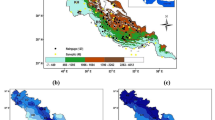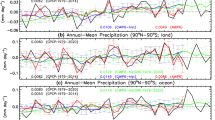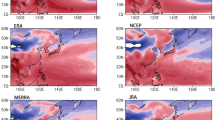Abstract
The development of subseasonal precipitation forecasts on regional scales is becoming an active area of research. Climate forecast models have shown deficiencies in predicting the extreme precipitation anomalies at medium to long-range timescales. This study explores the subseasonal relationships between tropospheric short-waves and regional precipitation anomalies across the continental United States and evaluates capabilities of the NCEP Climate Forecast System Version 2 (CFSv2) in resolving these relationships. A regional precipitation proxy is derived from the prediction of the upper tropospheric short-waves based on multiple linear regressions. Across the six climate regions defined by NOAA, the 30-day reforecasts of this short-wave based precipitation proxy are compared to identify the combinations of month and zonal wavenumber that exhibit the highest prediction score. Forecast of this precipitation proxy over certain regions is found to outperform the direct precipitation output of CFSv2 out to 4 weeks, suggesting a subseasonal predictability in precipitation that can be harvested from persistent circulation features.





Similar content being viewed by others
Notes
For example, forecasts initiated on 6, 11, 16, 21, 26, and 31 May were used as d-25, d-20, d-15, d-10, d-5, and d-0 lead times for June; 5, 10, 15, 20, 25, and 30 June (July) were used as d-25, d-20, d-15, d-10, d-5, and d-0 lead times for July (August). Lead time nomenclature is similar to that used in Zuo et al. (2013).
References
Ambrizzi T, Hoskins B, Hsu HH (1995) Rossby wave propagation and teleconnection patterns in the austral winter. J Atmos Sci 52(21):3661–3672
Becker EJ, Van Den Dool H, Peña M (2013) Short-term climate extremes: prediction skill and predictability. J Clim 26(2):512–531. doi:10.1175/JCLI-D-12-00177.1
Branstator G (2002) Circumglobal teleconnections, the jet stream waveguide, and the North Atlantic Oscillation. J Clim 15(14):1893–1910
Chen M, Xie P, et al (2008) CPC Unified Gauge-based Analysis of Global Daily Precipiation. In: Western Pacific geophysics meeting, Cairns, 29 July–1 August, 2008
Ding Q, Wang B (2005) Circumglobal teleconnection in the northern hemisphere summer. J Clim 18(17):3483–3505
Ding Q, Wang B, Wallace JM, Branstator G (2011) Tropical–extratropical teleconnections in boreal summer: observed interannual variability. J Clim 24(7):1878–1896
Gillies RR, Wang SY, Yoon JH, Weaver S (2010) CFS prediction of winter persistent inversions in the intermountain region. Weather Forecast 25(4):1211–1218
Hoskins BJ, Ambrizzi T (1993) Rossby wave propagation on a realistic longitudinally varying flow. J Atmos Sci 50:1661–1671
Kalnay et al (1996) The NCEP/NCAR 40-year reanalysis project. Bull Am Meteorol Soc 77:437–470
Saha S et al (2014) The NCEP Climate Forecast System version 2. J Clim 27:2185–2208. doi:10.1175/JCLI-D-12-00823.1
Schubert S, Wang H, Suarez M (2011) Warm season subseasonal variability and climate extremes in the Northern Hemisphere: the role of stationary Rossby waves. J Clim 24(18):4773–4792
Screen JA, Simmonds I (2014) Amplified mid-latitude planetary waves favour particular regional weather extremes. Nat Clim Change 4(8):704–709
Sooraj KP, Annamalai H, Kumar A, Wang H (2012) A comprehensive assessment of CFS seasonal forecasts over the tropics*. Weather Forecast 27(1):3–27. doi:10.1175/WAF-D-11-00014.1
Wang SY, Hipps LE, Gillies RR, Jiang X, Moller AL (2010) Circumglobal teleconnection and early summer rainfall in the US intermountain west. Theor Appl Climatol 102(3–4):245–252
Wang S-Y, Davies RE, Gillies RR (2013a) Identification of extreme precipitation threat across midlatitude regions based on short-wave circulations. J Geophys Res Atmos 118:11059–11074
Wang S-Y, Chia H-H, Gillies RR, Jiang X (2013b) Quasi-biweekly mode and its modulation on the diurnal rainfall in Taiwan forecasted by the CFS. Weather Forecast 28:981–993
Wang H, Schubert S, Koster R, Ham Y-G, Suarez M (2014) On the role of SST forcing in the 2011 and 2012 extreme U.S. heat and drought: a study in contrasts. J Hydrometeorol 15:1255–1273
Yuan X, Wood EF, Luo L, Pan M (2011) A first look at Climate Forecast System version 2 (CFSv2) for hydrological seasonal prediction. Geophys Res Lett 38:L13402. doi:10.1029/2011GL047792
Zuo Z, Yang S, Hu Z-Z, Zhang R, Wang W, Huang B, Wang F (2013) Predictable patterns and predictive skills of monsoon precipitation in Northern Hemisphere summer in NCEP CFSv2 reforecasts. Clim Dyn 40:3071–3088
Acknowledgments
The authors thank two anonymous reviewers whose thorough review and comments greatly improved this paper. Conversations with Oi-Yu (JoJo) Chung regarding statistical methodologies were much appreciated. This research was partially supported by DOE DE-FOA-0001531 and SERDP 17-RCSEED01-002.
Author information
Authors and Affiliations
Corresponding author
Rights and permissions
About this article
Cite this article
Schroeder, M., Wang, SY.S., Gillies, R.R. et al. Extracting the tropospheric short-wave influences on subseasonal prediction of precipitation in the United States using CFSv2. Clim Dyn 48, 3967–3974 (2017). https://doi.org/10.1007/s00382-016-3314-1
Received:
Accepted:
Published:
Issue Date:
DOI: https://doi.org/10.1007/s00382-016-3314-1




